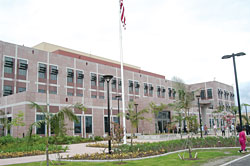|
|
I would like to relate the story of my friend and her brush with the US embassy here in Kathmandu. Prema is an architect and city-planner, trained in the US and currently living in Nepal. She is writing articles about Kathmandu's architecture and is looking at several prominent buildings in the city, including the new US embassy in Maharajganj.
Last week, Prema was headed to Bansbari with her family. As she was passing the US embassy, she thought she would take some pictures from the road for her article. She asked the taxi to wait as she stepped out to take a few shots, across the road from the embassy.
Men whistled, feet shuffled, armour dazzled. She was whisked into the embassy grounds by two armadillo-like security men and they confiscated her outdated Nikon camera. She asked them what the issue was and how it would be resolved. They said she had to go through The Procedure. She tried to understand what The Procedure was, and how long it would take (as her family was waiting outside in the taxi), but no one seemed to know.
Prema was taken through four layers of security personnel within 10 minutes. The guards kept telling her they were simply doing their job. She offered to delete the pictures, but that wouldn't suffice. She offered to leave the memory card with them...nope.
She finally told them they could keep her camera, but even that wouldn't do.
The Procedure, it turned out, was to have her detained without explanation, interrogated by a high-level American security officer, profiled with personal background and mugshots, and strongly reprimanded for breaking a US law in Nepal.
The well-heeled American security officer informed Prema it was against the law to take pictures of US government buildings. She didn't think it was a good time to tell him about the millions of tourists taking pictures of the White House. Finally, she was let go \'this one time\', he would not call the police to put her in jail. Prema left the embassy with her camera, no pictures, and chewing on the lessons she was force-fed.
This is what she told me:
"Personally, the embassy's security procedure seemed disproportionate and intimidating. It seems to be a misuse of their own resources. I realised how unnerving and helpless it feels to be at the mercy of armed and powerful authorities who represent the law, and who have no respect for your perspective. My respect for the press and for human rights groups has multiplied.
From an architect's perspective-full points to the US embassy. It has achieved what most architects can only aspire for-that the building's physical form and lack of harmony with the site embodies and reflects the culture and ethos of its inhabitants.
As a planner, I find the no-picture rule quite disturbing. It blurs the conceptual difference between the public and the private. If the embassy does not want their building to be scrutinised or photographed, wouldn't it be simpler to cover or hide the fa?ade (like they have done with Phora) than to mandate the behaviour of people on the street? Doesn't the public fa?ade of a building have the right to be accessed by the public?"
The US Embassy spent a lot of their security resources on my petite friend. In return, I have spent some resources in writing this article on her behalf, to spread public awareness of the law. The lesson to the Nepali public is: when you next trespass on that stretch of Maharajganj, please avert your gaze lest you break some US law in Nepal.




